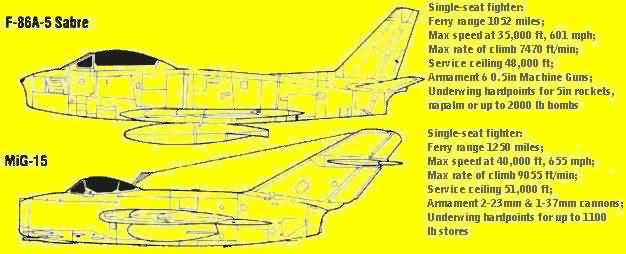
في 30 نوفمبر من سنة 1950 وبعد 6 اشهر من بدء الحرب الكورية عندما تعرضت قاذفة امريكية من نوع B-29 Superfortress- كانت تهاجم قاعدة جوية تابعة لكوريا الشمالية -تعرضت الى اضرار طفيفة عندما هاجمتها مقاتلة سريعة وصغيرة واصابتها ..لقد كانت المقاتلة سريعة لدرجة ان مشغل المدفع الخاص بالمدمرة لم يستطع رؤيتها او حتى تحديد نوعها او حتى الاطباق عليها بنظام التتبع الخاص بالمدفع الرشاش وبنفس الوقت لم تستطع طائرة لوكهيد Lockheed F-80 ان تلاحقها بسبب تسارع الطائرة المهاجمة
اثار تقرير طاقم المدمرة ذعر وفزع في سلسلة القيادة الامريكية ومع ان تقرير الطاقم لم يشير الى نوع موجود او معروف الا ان المخابرات الامريكية استنتجوا بان هذه الطائرة بالتاكيد هي مج-15 قادمة من القاعدة العجوية في Manchuria وانها قادمة من الصين التي سمح لها ستالين باستخدام المج-15 لحماية شنقهاي ...اذا الصين بدات تتدخل بالحرب الكورية بشكل قوي والتكنولوجيا السوفيتية بدات تنتشر في مناطق الصراع الامريكية

اصبح اختراق المج-15 السريع لتشكيلات اسراب القاذفات الامريكية نوع ب-29 مصدر رعب حقيقي للاطقم الامريكية I’ll tell you, everybody ared,” says former B-29 pilot Earl McGillcGill, as he describes the notable absence of radio chatter while he held his four-engine Boeing—the weapon system that had ended World War II—short of the runway for a mission against Namsi air base, near the border between North Korea and China. “On my first mission, we were briefed for heavy MiG interception. I was so scared on that day that I’ve never been frightened since, even when I flew combat missions in the B-52 [over Vietnam].” Earlier, the ready-room chatter had been filled with black humor. “The guy who briefed the navigation route had been an undertaker,” McGill says. He delivered the briefing in an undertaker’s stove-pipe hat.

في يوم كارثي سنة 1951 في شهر اكتوبر وسمي بالثلاثاء الاسود استطاعت المج-15 اسقاط 9 قاذفات امريكية وكانت المواجهه الاولى لطيار اسمه ميجيل ..
On one disastrous day in October 1951—dubbed Black Tuesday—MiGs took out six of nine Superforts. McGill’s first encounter with the craft had been typically brief. “One of the gunners called him out. He was a small silhouette,” McGill says. “That’s when I saw him…. [The gunners] were shooting at him.” McGill says the bomber’s centrally controlled firing system provided some protection against the fighters.
يقول طيار روسي كان يقود المج-15 انه عندما اطلق مدفع البي-29 النار علينا لم نكن نستطيع ان نميز هل القاذفة تحترق او دخان المدفع القاذفة ب-29 الرشاش هو مصدر الدخان ؟
يقول الطيار بان مدفع البي-29 كان قويا ولكن المج-15 كانت تلحق الاضرار باسرابها من مسافة 2000 قدم
MiG-15 pilot Porfiriy Ovsyannikov was on the other end of the B-29’s guns. “When they fired at us, they smoked, and you think, Is the bomber burning, or is it machine gun smoke?” he recalled in 2007, when Russian historians Oleg Korytov and Konstantin Chirkin interviewed him for an oral history of Soviet combat pilots who fought in World War II and Korea. (The interviews are posted on the website lend-lease.airforce.ru/english.) The historians asked Ovsyannikov to rate the B-29’s defensive weapons. His reply: “Very good.” But MiG pilots were able to open fire from about 2,000 feet away, and at that distance, says McGill, they could savage a B-29 formation.
يقول مدير متحف الجو والفضاء Robert van der Linden بان المج-15 فاجاتنا فقد كانت اسرع واكثر تسلقا واكثر قوة نارية من السابر-86
“The MiG-15 surprised the hell out of us,” says National Air and Space Museum curator Robert van der Linden. Compared to the North American F-86 Sabre, hastily introduced in combat after the MiGs showed up, “the MiG was faster, could outclimb it, and had more firepower,” he says. And Sabre pilots knew it.
الملازم تشارلز من سلاح الجو الامريكي يقول " نعم لقد كانت طائرة مخيفة ويتذكر اول مواجهاته معها وكيف اجبرت القاذفات الامريكية على البقاء على المدارج والطيران ليلا فقط
“You’re damned right it was intimidating,” says retired Air Force Lieutenant General Charles “Chick” Cleveland, remembering his first encounter with a MiG-15. He was flying a Sabre with the 334th Fighter-Intercepter Squadron over Korea in 1952. Only weeks before, the squadron commander, high-scoring World War II ace George Andrew Davis, was killed by the Soviet fighter. (Davis was posthumously awarded a Medal of Honor.) Now, pulling a tight turn to evade the MiG, Cleveland violated the Sabre’s unforgiving stall margin, snapped over, and briefly entered a spin, as he puts it, “right there in the middle of combat.”
يقول الطيار كليفلاند الذي واجه المج-15 ونجا منها "لقد كانت طائرة رائعه فلقد كانت المج-15 الصغيرة ناجحة في كوريا وفعلت ما لم تفعله الطائرات الالمانية في الحرب العالمية الثانية وهو اخراج القاذفات الامريكية من سماء المعركة من نوفمبر 1951 بقيت ب-29 على الارض صباحا ولم تطير الا ليلا فقط
Cleveland survived his mistake to become a Korean War ace with five confirmed MiG kills and two probables. Today, he’s president of the American Fighter Aces Association and still has respect for his adversary of 60 years ago. “Oh, it was a wonderful airplane,” he says from his home in Alabama. “You have to remember that the little MiG-15 in Korea was successful doing what all the Focke-Wulfs and Messerschmitts of World War II were never able to do: Drive the United States bomber force right out the sky.” From November 1951, B-29s stayed on the ground during the day; bombing missions were flown only at night.

لاحقا عرضت الولايات المتحدة عرض سخي لاي طيار يهرب من كوريا بالمج-15

يتبع لاحقا ان شاء الله ...








تعليق